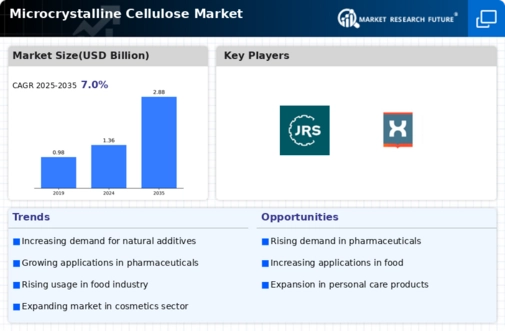Market Analysis
In-depth Analysis of Microcrystalline Cellulose MCC Market Industry Landscape
There are two primary submarkets within the microcrystalline cellulose industry: those based on wood and those based on non-wood. With more applications in the pharmaceutical industry expected to support continuing expansion, the wood-based category dominated the market revenue in 2021.
Microcrystalline cellulose from pharmaceutical grade is the one that is extracted from wood pulp which is the giant stacks of cellulose threads with lignin in between holding them together. This form, which has a better binding and plasticity energy than original cellulose, is produced by hydrolyzing cellulose and used as a medicinal diluent. What is interesting here is that the segment where wood is not present is set to witness the highest growth rates in the near future. Recently, there has been a great concern about the carbon emissions and the forest degradation caused by the increasing demand for wood for the production of microcrystalline cellulose. This has resulted to a shift in the focus of researchers who now have to look for suitable alternatives to wood-based raw materials.
The three major end-use industries namely pharmaceuticals, food and beverage, and personal care and cosmetic contribute to the different segments of the microcrystalline cellulose market. Market shares for pharmaceuticals were higher in 2021, and analysts foresee sustained growth, with accelerated growth rates over the few years ahead.
The outstanding attributes of microcrystalline cellulose of the pharmaceutical grade, obtained from wood, which is with its high binding potency and chemical inertness, render it in high demand. Whereas, the reason for it, often make it to be central in the pharmaceutical sector. On the contrary, it’s also predicted that the growth of the aspen market will be the highest of all due to the increasing demand for eco-friendly production systems and materials. This change was a consequence of the fact that there was a rise of concern over the emission of carbon and the cutting off of forests that in turn resulted in the development of new fibers and ingredients for making microcrystalline cellulose.
In 2021 the biopharmaceutical industry took the lead in the application market for microcrystalline cellulose due to its inert chemical nature and its use in dry binding. As soon as the expectations for growth are maintained throughout the period of the anticipated, this dominance should be retained. Even so, experts expect that the food and beverage industry will grow at a faster pace. This is because microcrystalline cellulose is used in a lot of different food and drink items, such as baked goods, frozen foods, dairy, and sweets. Microcrystalline cellulose has a great influence on market expansion due to its multiple uses, such as a fat substitute, a dry binder in pharmaceuticals, and an aid in maintaining food consistency.


 Source: Secondary Research, Primary Research, Market Research Future Database and Analyst Review
Source: Secondary Research, Primary Research, Market Research Future Database and Analyst Review


Leave a Comment